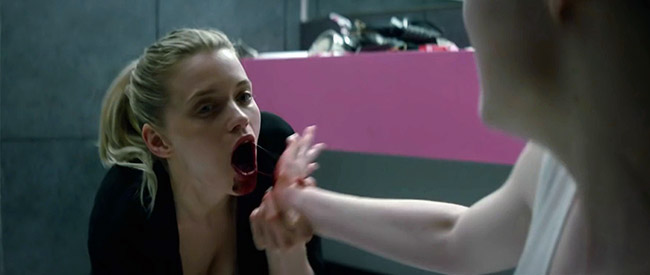THE NEON DEMON Nicolas Winding Refn’s The Neon Demon is a deceptively simple film. It’s about a 16-year-old girl (a gorgeous ingénue with an unfamiliar beauty played by Elle Fanning) who comes to LA from the hinterlands to start a modeling career. Spoiling none of the plot, this upstart’s great promise on the runway stirs the jealousy of the vicious, more established clique of models whose position she threatens to unseat. Horrible things ensue. That’s pretty much it.
A Philosophical Analysis It’d be very easy to argue that The Neon Demon is a movie about desire and, more specifically, about the tired metaphorical relationship desire has with cinema. There are hundreds of films in which we find cameras and gazes and beautiful people (usually women) as the object of those gazes, and these films have given rise to variously compelling questions about sexuality, vision, cinema and the nature of aesthetics. Demon certainly nods at this library of films and the shelves and shelves of criticism they’ve generated—but it then takes us further. The film dares us to ask not just why we care so much about beauty, but (quite literally) why we feel compelled to consume beautiful things. We’re not just talking about consumption for pleasure or entertainment value. We’re talking about a private consumption that eliminates other people’s chance to experience it—the instinct to own a painting hoarded away on display in your bedroom versus in a museum open to the public. Hence, the film is inherently political. Nations are convulsing around questions of their commitment to a collective wellbeing and trade-offs between social security and individual benefit. Capitalism today works extremely well for a small number of people and increasingly poorly for most everybody else. So when the established clique of models (spoiler!) kill and actually eat Fanning’s newcomer Jesse, their obvious objective is to keep her from displacing them in photo shoots and runway gigs. But their actual motive is to keep her beauty for their consumption alone.
The Neon Demon is a movie that could only make sense in a world where photographic capture is ubiquitous and instantaneous. This very second, there aren’t just “natural” eyes fixating on all of the rare and precious objects of attention in our world—there are also billions of artificial eyes, extending our gaze in every direction. We control the sensors, hunting the world’s beauty at an inconceivable rate. In 2016, our collective interest in swallowing the world’s beauty is arguably at a fever pitch. But are we capturing images for everyone’s benefit or our own? The movie’s most jarring sequence is quite literally when we learn that “the eye” (eg, Jesse’s actual eyeball) is indigestible. Her antagonistic model-predator-adversary (Abbey Lee) vomits up the girl’s optic nerves as if she’s allergic to them. This metaphor contains the film’s primary thesis: the consumption of beauty is never complete, never final. There is an illogic, an idiocy, to the private ownership of an aesthetic revelation. Why the title Neon Demon? The first option is of course Jesse: the luminous object of desire. But that’s not right. She’s not a demon, she’s just a tool manipulated by the system. She’s not neon (artificial light)—in fact, she’s the opposite. And she’s not possessed or demonic; she’s innocent and angelic. About midway through the film, one fashion world tastemaker says, “Beauty isn’t everything, it’s the only thing”—he rejects the artificial beauty of the fawning model (Bella Heathcote) who has had work done. The “neon demon” is probably the logic of consumption itself: our obsession with ingesting and owning (eg, eating) the brightest and best. To learn more about Film Independent, subscribe to our YouTube channel or follow us on Twitter and Facebook. You can catch up with the rest of our blog here. To learn how to become a Member of Film Independent, just click here.

